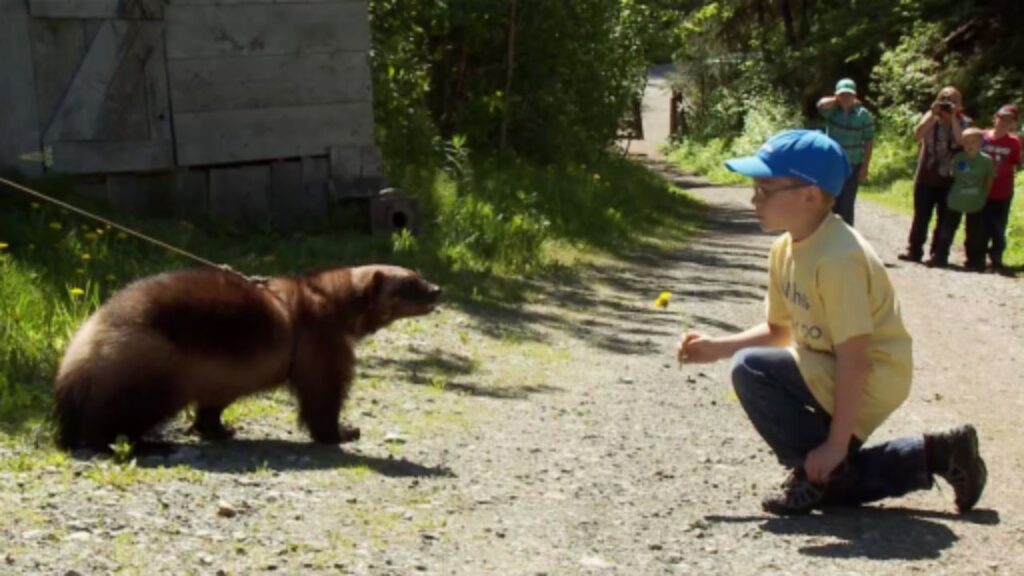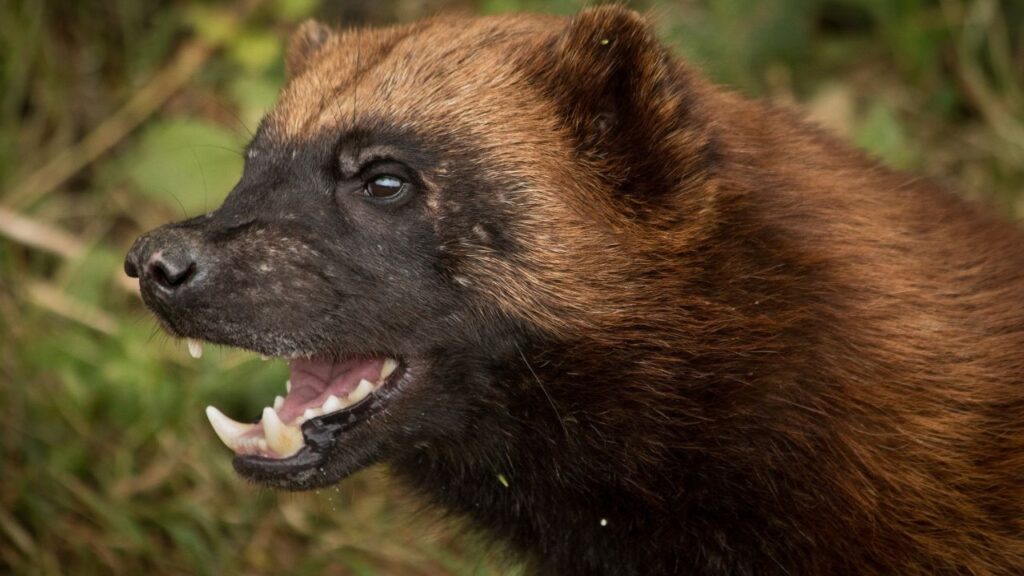Do Wolverines Attack Humans? Wolverines are generally shy and avoid humans, but they can be aggressive and potentially dangerous if cornered or provoked.
Wolverines have long captivated the imagination with their fierce reputation and tenacious nature. Often depicted as ferocious and unstoppable, these solitary animals are known for their remarkable strength and resilience, despite their relatively small size.
Found primarily in the remote and rugged wilderness of the Northern Hemisphere, wolverines are elusive creatures that few people encounter in the wild. However, their intimidating appearance and formidable reputation have led many to wonder: Do wolverines attack humans?
In this comprehensive article, we’ll explore this question in detail, examining the behavior of wolverines, the circumstances under which they might become aggressive, and how to stay safe if you find yourself in wolverine territory.
Contents
What Are Wolverines?
Physical Characteristics
Wolverines, scientifically known as Gulo gulo, are the largest members of the weasel family, a group that includes otters, ferrets, and mink. Despite being relatively small compared to other large carnivores, wolverines are incredibly powerful.
They typically weigh between 20 to 55 pounds, with males being larger and heavier than females. Wolverines have a stocky, muscular build, with a broad head, short legs, and a bushy tail that helps them maintain balance and stay warm in cold environments.
One of the most distinctive features of wolverines is their powerful jaws, which can crush bones and tear through frozen meat. [Do Wolverines Attack Humans?]
Their teeth are adapted for a carnivorous diet, allowing them to consume almost every part of their prey, including bones and cartilage. Wolverines also have sharp, retractable claws that they use for digging, climbing, and, if necessary, defending themselves.
Their thick, dark fur provides insulation against the cold and is often marked with lighter bands or patches, giving them a unique and rugged appearance.
Habitat and Behavior
Wolverines are found in the remote wilderness of the Northern Hemisphere, particularly in the boreal forests, tundra, and mountainous regions of Alaska, Canada, Scandinavia, and Russia. [Do Wolverines Attack Humans?]
They prefer areas with deep snow cover, which allows them to travel and hunt more efficiently. Wolverines are highly adapted to cold environments and are capable of covering vast distances in search of food. They are known to travel over 15 miles in a single day, often traversing rough and mountainous terrain.
Wolverines are solitary animals, meaning they live and hunt alone for most of the year. They are also highly territorial, with each individual wolverine maintaining a home range that can cover hundreds of square miles.
These ranges often overlap with those of other wolverines, but direct interactions between individuals are rare. When they do occur, these encounters are usually brief and can be aggressive, especially if territory or food is at stake.

Do Wolverines Attack Humans?
General Behavior Towards Humans
Wolverines are naturally reclusive and avoid human contact whenever possible. Unlike other large predators such as bears or wolves, wolverines do not typically seek out human settlements or food sources.
They are more likely to be found in remote wilderness areas far from human activity. When wolverines do encounter humans, their first instinct is usually to flee rather than confront.
This behavior is consistent with their general approach to avoiding danger—wolverines are bold, but they are not reckless. [Do Wolverines Attack Humans?]
Historical accounts and research suggest that wolverines pose little threat to humans. They are more interested in scavenging carcasses and hunting small to medium-sized animals than in interacting with people. However, like all wild animals, wolverines can become aggressive if they feel threatened or cornered.
Circumstances Leading to Aggression
While wolverines are not typically aggressive towards humans, there are certain situations in which they might display hostility. Understanding these circumstances is key to avoiding conflict and staying safe in wolverine territory.
- Defending Territory: Wolverines are fiercely territorial, and their home ranges are essential to their survival. If a human unknowingly encroaches on a wolverine’s territory, especially near a den or a fresh kill, the wolverine might perceive the person as a threat. In such cases, the wolverine may become defensive and aggressive in an attempt to protect its territory and resources.
- Protecting Offspring: Like many wild animals, wolverines are highly protective of their young. If a mother wolverine feels that her cubs are in danger, she may attack to defend them. This behavior is common among many animal species and is driven by the instinct to ensure the survival of their offspring. [Do Wolverines Attack Humans?]
- Feeling Cornered: Wolverines are known for their boldness, but they are not invincible. If a wolverine feels trapped or cornered by a human or a dog, it might lash out in self-defense. This can happen if a wolverine is surprised or if it perceives that it has no escape route. In such situations, the wolverine may use its powerful jaws and sharp claws to defend itself.
- Competition for Food: Wolverines are opportunistic feeders, often scavenging on carcasses left by other predators or by natural causes. If a human or a dog approaches a wolverine while it is feeding, the animal may become aggressive to protect its food source. This behavior is driven by the wolverine’s need to secure enough food to survive in its harsh environment.

Documented Wolverine Attacks
Wolverine attacks on humans are extremely rare, and documented cases are few and far between. Most of these incidents involve humans accidentally stumbling upon a wolverine or its den, leading to a defensive response from the animal.
In many cases, these attacks are minor and result in only superficial injuries, as wolverines typically try to escape rather than engage in prolonged conflict. [Do Wolverines Attack Humans?]
One of the most well-known incidents occurred in Alaska, where a trapper was reportedly attacked by a wolverine that had become entangled in one of his traps.
The wolverine, in a panic, lashed out at the trapper, causing injuries that required medical attention. However, such cases are exceptions rather than the norm, and wolverines are generally not considered a significant threat to human safety.
Comparative Danger
When comparing the danger posed by wolverines to other wild animals, it’s clear that they are not among the top threats to humans.
Larger predators like bears, mountain lions, and wolves are far more likely to pose a danger to people, especially in areas where human-wildlife conflicts are common. Wolverines, on the other hand, are more likely to avoid human interaction whenever possible.
In fact, wolverines are often more vulnerable to human activities than humans are to wolverines. Habitat loss, climate change, and human encroachment on wilderness areas have all contributed to a decline in wolverine populations in some regions.
As a result, conservation efforts are underway to protect these animals and their habitats, ensuring that they can continue to thrive in the wild. [Do Wolverines Attack Humans?]
Are Wolverine Attacks Dangerous?
Potential Harm from Attacks
If a wolverine were to attack a human, it could potentially cause significant harm due to its powerful jaws and sharp claws. A wolverine’s bite can easily tear through flesh, and its claws can cause deep wounds.
However, because of their size, wolverines are not capable of the same level of damage as larger predators like bears or big cats. Most attacks, if they occur, are likely to result in superficial injuries rather than life-threatening ones.
It is important to note that wolverines are not naturally inclined to attack humans. They are much more likely to flee or avoid confrontation unless they feel that they have no other choice. Even when they do attack, wolverines typically aim to drive the perceived threat away rather than to kill.
This is consistent with their behavior towards other animals, where they use their strength and aggression to intimidate rather than to inflict serious harm. [Do Wolverines Attack Humans?]
Surviving a Wolverine Encounter
Surviving a wolverine encounter is largely about avoiding conflict in the first place. If you see a wolverine, it’s best to slowly back away and give the animal plenty of space to retreat. Wolverines are more likely to run away than to engage in a fight with a human.
However, if a wolverine does charge, standing your ground, making yourself appear larger, and making loud noises can help deter the animal. Avoid turning your back or running, as this could trigger a predatory response.
If you are carrying bear spray, it can be an effective deterrent against a charging wolverine. The spray creates a cloud of irritant that can disorient the animal and give you time to escape.
However, it’s important to use bear spray only as a last resort and to follow the manufacturer’s instructions carefully. [Do Wolverines Attack Humans?]

How to Avoid Wolverine Encounters?
Best Practices in Wolverine Territory
When hiking or camping in areas known to be home to wolverines, it’s essential to follow some basic safety guidelines:
- Stick to Trails: Staying on established trails reduces the risk of surprising a wolverine in its natural habitat. Wolverines are more likely to be encountered off-trail in dense forests or near remote mountain passes.
- Avoid Dens and Carcasses: If you come across what appears to be a wolverine den or a fresh kill, move away quickly and quietly to avoid provoking the animal. Wolverines are highly protective of their dens and food sources and may become aggressive if they feel threatened.
What to Do If You See a Wolverine
If you encounter a wolverine in the wild, the best course of action is to stop and assess the situation. Most wolverines will not approach humans and will likely move away on their own.
However, if the wolverine appears agitated or starts to approach, slowly back away while keeping your eyes on the animal. Do not make any sudden movements or attempt to run, as this could provoke an attack.
In some cases, making yourself appear larger by raising your arms or holding your backpack above your head can help deter a wolverine. [Do Wolverines Attack Humans?]
Speaking in a calm, firm voice can also signal to the animal that you are not prey. Remember, wolverines are intelligent animals that can assess threats, and they are more likely to retreat if they perceive you as a formidable opponent.
Protecting Yourself in an Attack
In the unlikely event that a wolverine does attack, use any available objects—such as a walking stick, backpack, or even rocks—to protect yourself. Aim to create distance between you and the wolverine, and try to make yourself appear larger by raising your arms or jacket.
Loud noises can also help to scare off the animal. If the wolverine manages to bite or scratch you, seek medical attention immediately, as even minor wounds can become infected.
Reporting Wolverine Sightings
If you encounter a wolverine, especially if it displays unusual or aggressive behavior, it’s important to report the sighting to local wildlife authorities. These reports help researchers monitor wolverine populations and behaviors, contributing to conservation efforts and ensuring public safety.
In some regions, wolverine sightings are rare enough to be considered significant, and your report could provide valuable data for ongoing studies.

Final Verdict
Wolverine attacks on humans are extremely rare, and these animals generally prefer to avoid human contact. [Do Wolverines Attack Humans?]
While they are capable of inflicting harm if threatened, their natural behavior leans towards evasion rather than aggression. By respecting their territory and following safety guidelines, the risk of a dangerous encounter with a wolverine is minimal.
In most cases, wolverines are more interested in surviving in their harsh environments than in interacting with people, and their elusive nature means that they pose little threat to human safety.
See Also: Do Otters Attack Humans? The Dark Side of Otters!
FAQs
Are wolverines dangerous to pets?
Wolverines can be a threat to small pets if encountered in the wild, particularly if the pet is perceived as a threat or if the wolverine is defending its territory. Pet owners should exercise caution when walking dogs in wolverine habitat and keep them on a leash to prevent encounters.
What should I do if I see a wolverine in my yard?
If you see a wolverine in your yard, remain calm and do not approach it. Slowly move indoors and contact local wildlife authorities to report the sighting. Wolverines in residential areas are likely just passing through, but it’s important to avoid interaction.
How common are wolverine encounters with humans?
Wolverine encounters with humans are very rare due to their reclusive nature and preference for remote, sparsely populated areas. Most people will never see a wolverine in the wild, and those who do are unlikely to experience any aggression.
Do wolverines hunt in packs?
No, wolverines are solitary hunters and do not hunt in packs. They are highly territorial and usually avoid others of their kind except during mating season. Wolverines rely on their strength and agility to take down prey, often targeting animals much larger than themselves.
Can wolverines be tamed or kept as pets?
Wolverines are wild animals with strong territorial instincts, making them unsuitable as pets. They require large territories and specific conditions that are difficult to replicate in captivity. Additionally, their aggressive nature and powerful jaws make them dangerous to handle.
Conclusion: Do Wolverines Attack Humans?
Wolverines are fascinating creatures known for their strength, resilience, and tenacity. While they are not typically a threat to humans, it is important to understand their behavior and to respect their space if you find yourself in wolverine territory.
By following safety guidelines and being aware of your surroundings, you can minimize the risk of a dangerous encounter. Wolverines, like all wild animals, play a crucial role in their ecosystems, and our coexistence with them is best achieved through mutual respect and understanding.
Whether you are a hiker, a camper, or simply someone interested in wildlife, knowing how to stay safe around wolverines is key to enjoying the great outdoors. [Do Wolverines Attack Humans?]

Hello, I am Rosa Ellis, a mother of two and a wildlife blogger. I grew up in New York City, but I love exploring forests. I’ve traveled to places like Yellowstone National Park and the Amazon Rainforest to see animals up close. I know a lot about animal behavior and which animals can be dangerous to humans. Thanks for visiting my blog!

